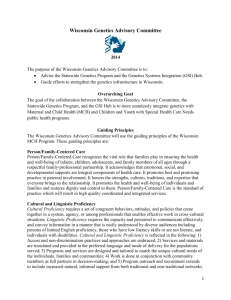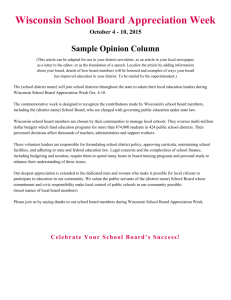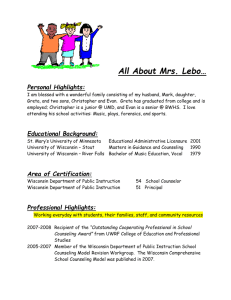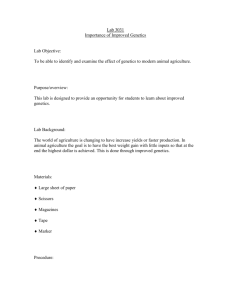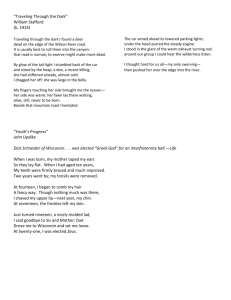Investigating Mendelian Genetics with Wisconsin Fast Plants™ Activity
advertisement
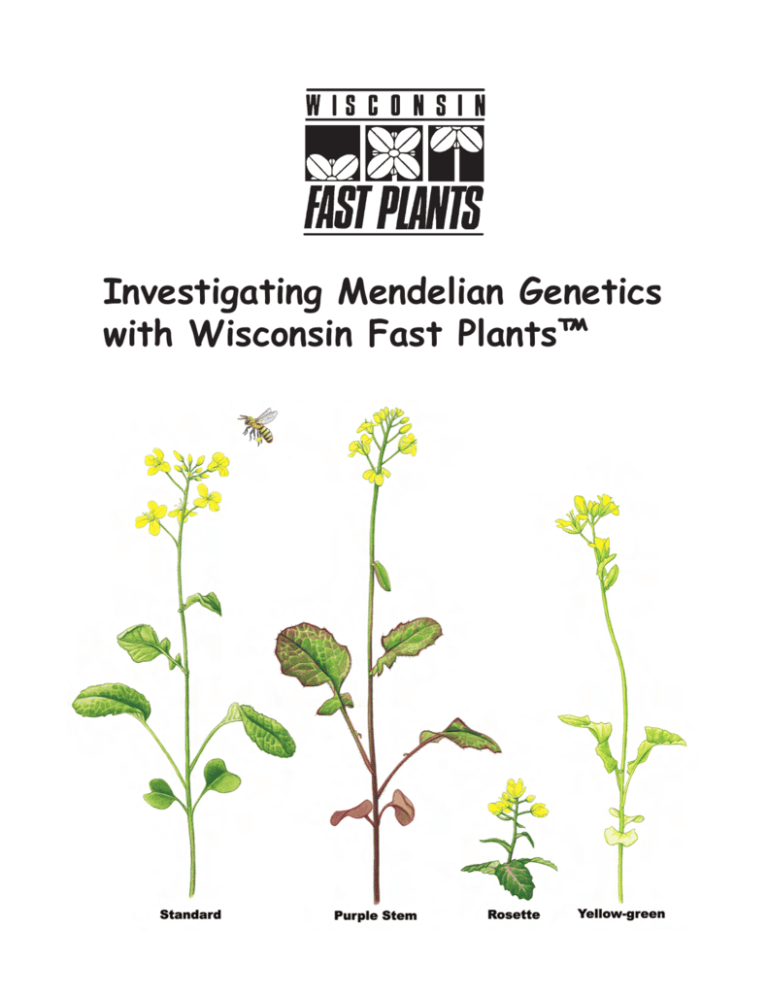
Investigating Mendelian Genetics with Wisconsin Fast Plants™ Investigating Mendelian Genetics with Wisconsin Fast Plants™ Table of Contents Introduction to Investigating Mendelian Genetics with Wisconsin Fast Plants™ . . . . . . . . . 4 Wisconsin Fast Plants™ Genetics Background Information . . . . . . . . . . . . . . . . . . . . . . . . . 4 Growing Tips (See Growing Instructions for complete guide) . . . . . . . . . . . . . . . . . . . . . . . . 5 Terminology . . . . . . . . . . . . . . . . . . . . . . . . . . . . . . . . . . . . . . . . . . . . . . . . . . . . . . . . . . . . . . 5 Genetics Activities Overview . . . . . . . . . . . . . . . . . . . . . . . . . . . . . . . . . . . . . . . . . . . . . . . . . 6 Monohybrid Activity Overview . . . . . . . . . . . . . . . . . . . . . . . . . . . . . . . . . . . . . . . . . . . . . . . 6 Monohybrid Activity . . . . . . . . . . . . . . . . . . . . . . . . . . . . . . . . . . . . . . . . . . . . . . . . . . . . . . . . 8 Genetics Investigation Procedure . . . . . . . . . . . . . . . . . . . . . . . . . . . . . . . . . . . . . . . . . . . . . . 8 Discussion Questions . . . . . . . . . . . . . . . . . . . . . . . . . . . . . . . . . . . . . . . . . . . . . . . . . . . . . . . 9 Dihybrid Genetics Activity . . . . . . . . . . . . . . . . . . . . . . . . . . . . . . . . . . . . . . . . . . . . . . . . . . 10 Chi-Square Test . . . . . . . . . . . . . . . . . . . . . . . . . . . . . . . . . . . . . . . . . . . . . . . . . . . . . . . . . . . 13 For additional activities, student pages and related resources, please visit the Wisconsin Fast Plants’ website at www.fastplants.org Investigating Mendelian Genetics with Wisconsin Fast Plants™ Activity Materials Wisconsin Fast Plants™ Monohybrid Genetics Kit Components Wisconsin Fast Plants™ Dihybrid Genetics Kit Components • 1 pack of 25 Purple Stem Wisconsin Fast • 1 pack of Non-Purple Stem Wisconsin Fast Plants™ Seeds (parent) Plants™ Seeds (parent) • 1 pack of 25 Non-Purple Stem Seeds (parent) • 1 pack of Yellow-Green Leaf Wisconsin Fast • 1 pack of 200 F1 Wisconsin Fast Plants™ Seeds • 1 pack of F1 Wisconsin Fast Plants™ Seeds (from a cross of the parent strains [anl/ANL]) Plants™ Seeds (parent) • 1oz pelleted fertilizer (from a cross of the parent strains [anl/ANL, • 2 watering trays ygr/YGR]) • 2 watering mats • 1oz pelleted fertilizer • wicks (package of 70) • 2 watering trays • 1 packet anti-algal square (2 squares per packet) • 2 watering mats • 8 watering pipettes • wicks (package of 70) • 1 L potting soil • 1 packet anti-algal square (2 squares per packet) • 1 package of dried bees • 8 watering pipettes • four 4-cell quads • 1 L potting soil • 16 support stakes • 1 package of dried bees • 16 support rings • four 4-cell quads • Growing Instructions • 16 support stakes • 16 support rings • Growing Instructions Investigating Mendelian Genetics with Wisconsin Fast Plants™ Welcome to the wonderful world of Wisconsin Fast Plants™ and investigations to engage students in studying Mendelian genetics with hands-on experimentation. Originating from decades of innovative research by Professor Paul Williams at the University of WisconsinMadison, Wisconsin Fast Plants™, Brassica rapa, are now used by millions of students worldwide. The investigations in this booklet were designed for students to develop understanding of the following biological concepts and skills: • Mendel’s law of segregation and law of independent assortment • Inheritance of 2 traits • How genotypes influence phenotypes • Scientific inquiry, including interpretation of evidence Wisconsin Fast Plants™ Genetics Background Information Phenotypes and Genotypes Rapid-cycling Brassica rapa has been designated the cultivar name “RCBr.” Anthocyanin is a purple pigment found in many plants, including Wisconsin Fast Plants™. Anthocyanin is best observed when the plants are 4-7 days old. Look on the stems and hypocotyls, under the cotyledons, and at the leaf tips. A single gene, the anthocyaninless gene (anl), in Wisconsin Fast Plants™ regulates whether or not anthocyanin will be expressed. In the homozygous, recessive form (anl/anl), anthocyanin expression is completely suppressed, and the plants appear a bright green color (which is the “non-purple stem ” phenotype). If the genotype is anl/ANL or ANL/ ANL, then anthocyanin is expressed at varying levels and the plants are the “purple stem” phenotype. The genotype of the wild type is ANL/ANL. The yellow-green gene (ygr) in Wisconsin Fast Plants™ determines whether the leaves will be yellow-green or green in color. In the homozygous, recessive form (ygr/ygr), the leaves appear a pale, yellow-green color (which is the “yellow-green leaf” phenotype). If the genotype is ygr/YGR or YGR/YGR, then the leaves appear green (which is the “green leaf” phenotype). The genotype of the wild type is YGR/YGR. The rosette mutant stock is Wisconsin Fast Plants™ stock that is homozygous for the recessive mutant gene, ros, a conditioning deficiency in gibberellin that results in a short, rosette plant form. In the homozygous, recessive form (ros/ros), the plants have the rosette form. If the genotype is ros/ROS or ROS/ROS, then the plants have the standard form. The genotype of the wild type is ROS/ ROS. Growing Tips (See Growing Instructions for complete guide) • To ensure high seed yields and to optimize expression of the genetic traits used in this investigation, follow the Growing Instructions carefully. • It is easiest to observe the purple color on the hypocotyls (stems) when the plants are 4-7 days old. • The intensity of purple color is affected by the environment. More light yields a deeper purple color, as does reduced fertilizer. • Do not germinate Yellow-Green Leaf plants in Petri plates. The yellow-green color is virtually indistinguishable from the green color when seeds are germinated in Petri plates. Use a soil medium instead. • Expect an approximate 9:3:3:1 ratio of plants in the F2 generation. Due to the random nature of gamete segregation, an exact 9:3:3:1 ratio is unlikely to be observed. Use the ratio as a foundation for understanding the Law of Segregation. (Note: The rosette phenotype can be induced to grow normally by applying exogenous gibberellin in the form of gibberellic acid.) Terminology P1 = maternal parent P2 = paternal parent F1 = first-generation offspring, the result of crossing P1 and P2 plants F2 = secondgeneration offspring, the result of intermating the F1 plants geNETICS ACTIVITIES OVERVIEW Since the dawn of agriculture, humans have been trying to improve and increase their food supply. Historically, this was done by selecting the best plants and animals, then breeding them to get the tastiest, hardiest, most nutritious, or most appealing offspring. But no one really understood how these traits were inherited. Many people believed that traits “blended” in the offspring, or that only one parent passed a trait on to its offspring. In the mid-1800’s, a monk named Gregor Mendel gathered evidence that began explaining how inheritance works. Mendel studied discrete and contrasting traits. For example, the traits that he explored in pea plants included tall vs. short plants and purple vs. white flowers. His careful, repetitious work yielded two principles of genetics: the Law of Segregation and the Law of Independent Assortment. This activity is designed for students to engage in a hands-on experiment to see evidence for these two principles. QUESTIONS • How can you distinguish whether the mutant trait you are using is inheritable or is the result of environmental effects? • If the mutant type is under genetic control, is it conditioned by a single gene, a few genes, or many genes? What clues will help you determine how many genes are involved? • If a single gene controls the mutant type, how will you determine which is the dominant and which is the recessive? • What is your hypothesis about the inheritance of the mutant trait? Key Concepts • Law of Segregation: Paired alleles separate during the formation of gametes. • Law of Independent Assortment: Each allele segregates independently of the other allele in gamete formation. • Alleles retain their identity during gamete production and pollination/ mating. • Two alleles (one from each parent) are paired in the offspring; this constitutes the genotype of a trait. • The offspring’s phenotype is based on the expression of both alleles; one allele may “mask” the expression of another in a dominant/recessive relationship, or both alleles may contribute to the apparent phenotype. Genetics Monohybrid Activity Overview In this activity, students will observe three generations of Wisconsin Fast Plants™; students will investigate paternity by observing phenotype and inferring genotype. This investigation spans the entire life cycle of the mother and father (parent) generation (P1 and P2) and the first-generation offspring (F1) of plants; and an additional nine days allow students to observe the second generation offspring (F2). This activity is designed for students to investigate the inheritance of a single gene in Wisconsin Fast Plants™. Note: To ensure success of the plants — and to optimize conditions for expression of the genetic traits used in this investigation — it is important that you carefully follow the enclosed Wisconsin Fast Plants™ Growing Instructions flyer. Materials Wisconsin Fast Plants™ seeds - Seeds of two generations are included: wild-type RCBr seeds (P1) (non-purple stem, green, standard) mutant-type seeds (P2) (purple stem [anl/anl], yellow-green [ygr/ygr], or rosette [ros/ros]) F1 non-purple stem, yellow-green leaf growing systems Each growing system includes: • 1 circular watermat • 1 long watermat wick • 1 small container • 1 large container (reservoir) • 4 pots • 4 small blue watermat wicks Three Possible Mutants 1. Anthocyaninless - mutant gene anl in the homozygous condition, anl/anl, blocks the expression of anthocyanin (results in completely green seedlings). 2. Yellow-green - mutant gene ygr in the homozygous condition, ygr/ygr, produces yellow-green cotyledons and leaves. 3. Rosette - mutant gene ros in the homozygous condition, ros/ros, results in gibberellin deficiency and leads to lack of stem elongation. • potting mix • fertilizer • stakes and ties • labels Genetics Monohybrid Activity Genetics Investigation Procedure In this investigation, you and your classmates will be given the seeds from one generation of Wisconsin Fast Plants™: the first-generation offspring (F1). Four days after planting, you will be able to make observations about the phenotype of the young plants. Your teacher will plant seeds from the previous generation, the mother (P1) and father (P2) generation. How will you distinguish whether the mutant trait you are using is inheritable? First Generation (F1 Hybrid) Day 1 Follow the “Growing Instructions” and plant F1 seeds in all four cells of your quad. Be sure to label your quad. Your teacher will plant a quad of each of the parental seed types (wild type and mutant type) for comparison. Day 4 to 5 Compare the F1 plants and both parental types. Record the number of wild-type and mutant plants that you observe among the F1 plants in a data table. Thin to the most vigorous plant in each cell. Day 14 to 18 Pollinate plants. Gather pollen on a bee stick from one of your F1 plants and use it to pollinate another F1 plant (there should be two or three flowers open on most plants when you start pollinating). Pollen may be exchanged among as many of the F1 plants as you wish (within your quad or among all plants in the class; the more, the better at this stage). Do not worry about removing the anthers from a plant being pollinated; because the wild-type RCBrs are self-incompatible, little self-pollination will occur. Be sure that pollen from the parental-type demonstration plants is not used for these pollinations. After pollinating, insert the bee stick in the potting mix at the base of one of your plants. Pollinate plants about 2 and 4 days later. It is best to pollinate six to eight flowers. After your last pollination, pinch or cut off all un-opened buds and shoots so that uncontrolled pollinations cannot occur. Day 20 to 45 Continue to remove new buds and shoots for the next 2 weeks. Keep plants watered and growing for 3 weeks after you finish pollinating to allow the seeds to ripen. Dry plants and harvest seeds as described in the “Growing Instructions.” Seeds from your plants may be combined. Genetics Second Generation (F2) Day 1 The mutant traits anl, ygr, and ros, are all recognizable at the seedling stage. However, ygr (yellow-green leaf) need to be grown in soil because the yellow-green color is nearly indistinguishable when seeds are germinated in Petri dishes. If using ygr, repeat the planting procedure outlined for the First Generation to grow second generation seedlings (see the growing instructions for detailed information about planting and growing Wisconsin Fast Plants™ in soil). If using the Petri dish method, place one filter paper disc in the lid of a Petri dish. Write your name and the symbol of the mutant in pencil on the filter paper. Add water until the paper is wet; pour off excess water. Place 25 seeds in four neat rows on the upper twothirds of the filter paper. Place the cover on the dish and stand the dish in about 2 cm of water in a reservoir. Tilt the dish slightly so that water collects at the bottom and place the dish under the light bank. Seeds should all be above the water line. Day 3 to 5 Observe seedlings and record numbers of mutant and wild-type plants in a data table. 3-5 Day Seedling Discussion Questions 1. Describe the plants in the F1. What does this suggest about the inheritance pattern of the mutant trait? 2. What do the combined class data for the F2 suggest about the inheritance of the mutant trait? (Remember to consider the number of genes involved as well as dominance or recessiveness.) 3. What can you conclude from the x2 and probability values? 4. Are the deviations from a 3:1 ratio in the F2 significant? 5. Do the results agree with your original hypothesis? If not, what is your modified hypothesis? 6. What additional cross(es) would you do to verify your hypothesis? 7. If the mutant trait you used was rosette, when counting the number of rosette plants germinating in the F2 generation, the assumption is made that seeds not germinating are rosettes. Would this assumption be valid if you were using F2 seeds that had been produced by a previous year’s class instead of your own freshly harvested seeds? Explain. Genetics Dihybrid Genetics Activity This activity follows the same basic procedure as the monohybrid activity; however, the P1 and P2 plants are homozygous for two traits, one recessive and one dominant. There are four phenotypes used for this dihybrid genetics investigation: • Non-Purple - (green) no purple anthocyanin pigment is expressed in the plant (anthocyaninless). The genotype for this single gene recessive mutant is anl/anl • Purple - a pigment known as purple anthocyanin is visible on the hypocotyl. This trait is wild type (dominant) for anthocyaninless and is referred to as ANL/ANL Note: Anthocyanin is best observed when the plants are 4–7 days old. Look for anthocyanin expression on the stems and hypocotyls, under the cotyledons, and at the leaf tips. • Yellow Green - this genotype, ygr, when homozygous (ygr/ygr) produces a plant that is lighter green than the normal green Fast Plant • Normal Green - this genotype is ild-type (dominant) for yellow green and is referred to as YGR 10 Genetics Test Cross The test cross is the essential cross in genetic analyses that provides the most informative indications of independent assortment or linkage between two traits being tested. In the test cross, F1 progeny are crossed to a stock that is homozygous for the mutant alleles being examined for linkage. The power of the test cross in linkage mapping is that the combined recombinant frequency (recombinant class count/total) is equal to genetic map units separating the two traits. m.u.= recombinant class count/total In testing two unlinked recessive mutants the frequency of each parental class and each of the two expected recombinant classes is 0.25. Consider recovering the recombinant mutant class from your F2 to be used as a tester. 11 Genetics Chi-Square Test A test that is often applied to determine how well observed ratios fist expected statistical ratios is known as the chi-square (x2) test. This test calculates the deviations of observed numbers from expected numbers into a single numerical value called x2. The difference between the number observed and the number expected for a phenotype is squared and divided y the number expected. This is repeated for each phenotype class. The x2 value consists of the summation of these values for all classes. The formula for x2 (Suzuki, et al., 1986) is: (observed – expected)2 x2 = total of -------------------------------- expected over all cases Associated with each x2 value is a probability that indicates the chance that, in repeated experiments, deviations from the expected would be as large or larger than the ones observed in this experiment. In the following table, the column “Degrees of Freedom” is one less than the number of different phenotypes possible. In this experiment we have two possible phenotypes (the normal and the mutant) so there are 2 – 1 = 1 degree of freedom. If the probability is greater than 5% (0.05), we accept the observed data. 12 Genetics Put Your Results to the Test! Put your claims to a test! Was the ratio of the phenotypes in the F2 generation what you predicted it would be? Was it even close? A x2 will compare your observations with your hypothesis. The x2 test calculates (1) the deviation between your observed numbers and your expected numbers and (2) the probability that the deviation is due to chance or that the deviation is significant. If the deviation is merely due to chance, then the results do not disprove your hypothesis. If the deviation is significant, then your results do not support your hypothesis and you reject your hypothesis. In either case, a scientist would then run more tests to see if the results were repeatable. 13 Genetics 14 Phenotypes and Genotypes Rapid-cycling Brassica rapa has been designated the cultivar name “RCBr.” Purple stem Wisconsin Fast Plants™ contain anthocyanin, a purple pigment found in many plants, including Wisconsin Fast Plants™. Anthocyanin is best observed when the plants are 4-7 days old. Look on the stems and hypocotyls, under the cotyledons, and at the leaf tips. A single gene, the anthocyaninless gene (anl), in Wisconsin Fast Plants™ regulates whether or not anthocyanin will be expressed. In the homozygous, recessive form (anl/anl), anthocyanin expression is completely suppressed, and the Three Monohybrid Options plants appear a bright green color (which is the “non-purple stem ” phenotype). If the genotype is anl/ANL or ANL/ ANL, then anthocyanin is expressed at varying levels and the plants are the “purple stem” phenotype. The genotype of the wild type is ANL/ANL. The yellow-green gene (ygr) in Wisconsin Fast Plants™ determines whether the leaves will be yellow-green or green in color. In the homozygous, recessive form (ygr/ygr), the leaves appear a pale, yellow-green color (which is the “yellow-green leaf” phenotype). If the genotype is ygr/YGR or YGR/YGR, then the leaves appear green (which is the “green leaf” phenotype). The genotype of the wild type is YGR/YGR. Dihybrid F2 Phenotypes


